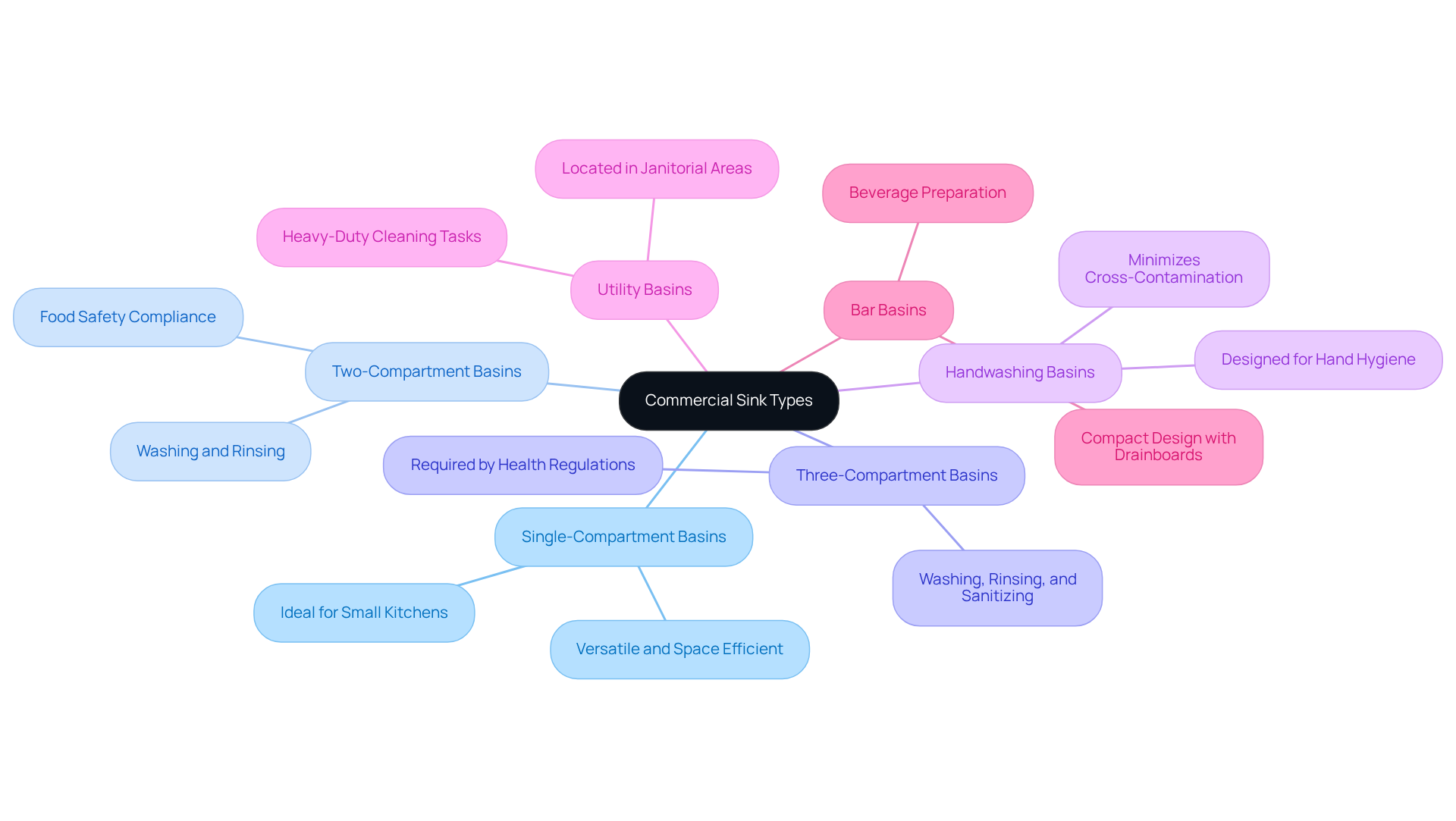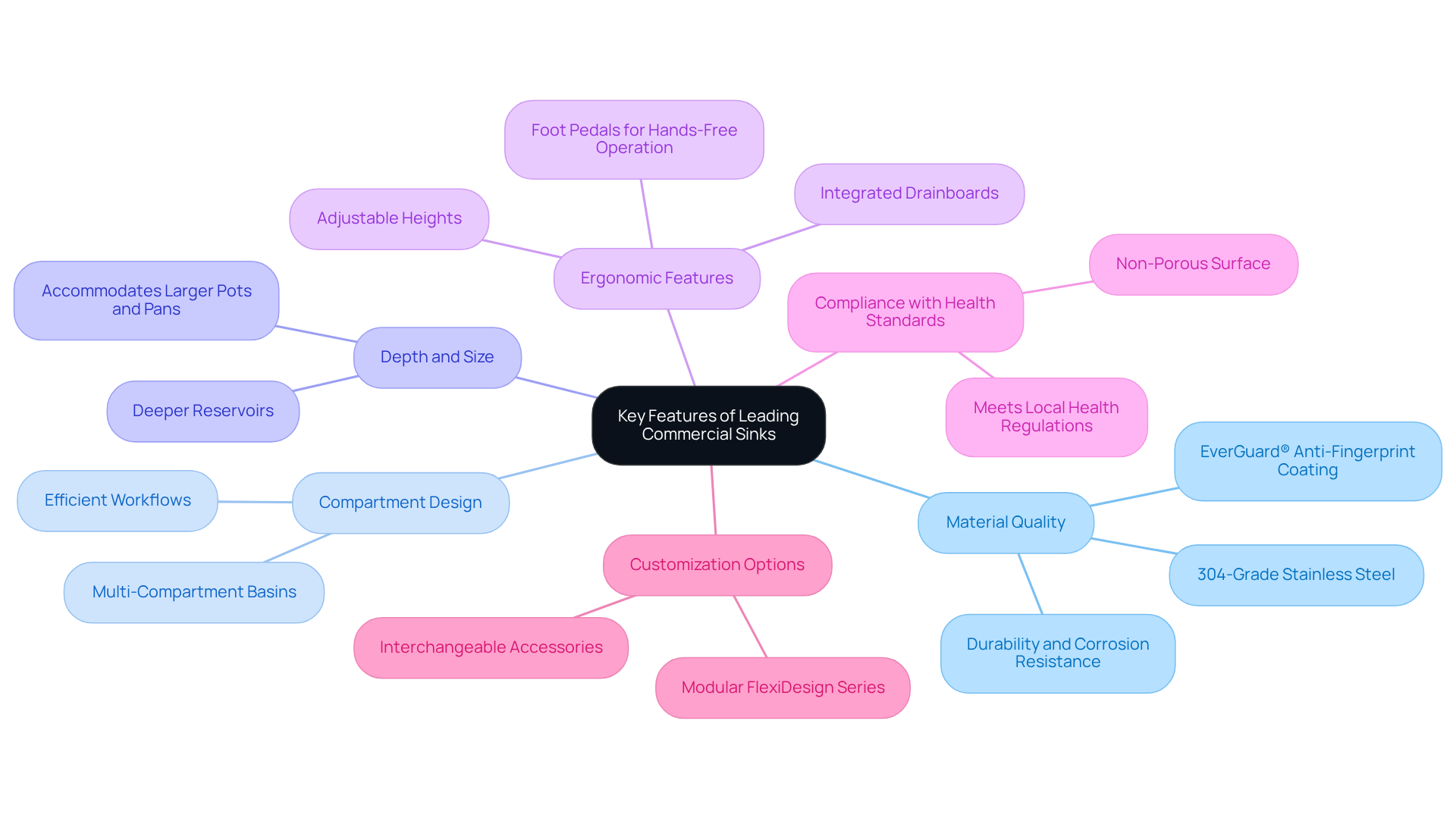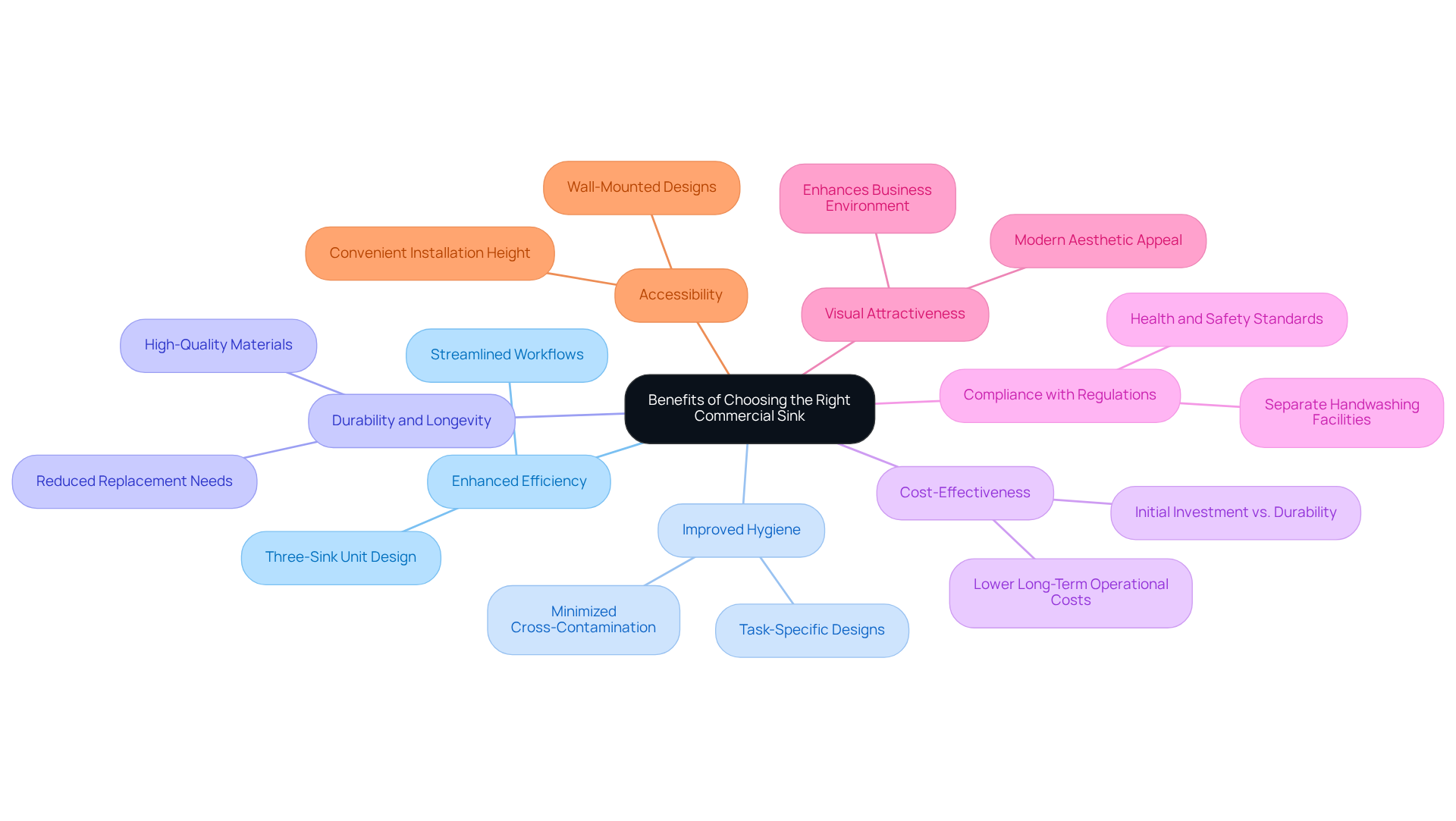Overview
This article provides a comprehensive comparison of various types of commercial sinks, meticulously highlighting their features, benefits, and optimal applications across different operational settings.
It asserts that the selection of the appropriate sink type—be it single, two, or three-compartment basins—significantly enhances workflow efficiency and ensures adherence to health regulations.
This underscores the critical role that choosing the right sinks plays in maintaining hygiene and operational effectiveness in commercial kitchens.
Introduction
Commercial sinks serve as more than mere functional fixtures; they are essential components in upholding hygiene and efficiency across various business environments. With a broad spectrum of options available—from single-compartment basins, perfect for compact kitchens, to three-compartment units that are crucial for adhering to health regulations—grasping the distinct features and advantages of each type is vital for any establishment.
Nevertheless, the challenge lies in choosing the right sink that not only fulfills operational requirements but also optimizes workflow and safety standards. Therefore, what are the critical factors to consider when evaluating commercial sinks, and how can businesses ensure they select the most suitable option for their specific needs?
Overview of Commercial Sink Types
Commercial sinks can be classified into various types, each designed for specific functions and operational needs.
-
Single-Compartment Basins provide versatility and space efficiency, making them ideal for fundamental washing activities, particularly in smaller kitchens or catering trucks.
-
Two-Compartment Basins enhance operational flexibility by facilitating washing and rinsing in distinct bowls, which is crucial for upholding food safety regulations in professional kitchens.
-
Three-Compartment Basins, frequently found in restaurants, aid in washing, rinsing, and sanitizing, ensuring adherence to health regulations and enhancing hygiene. Numerous health regulations mandate a three-basin unit as a backup to business dishwashers, underscoring its importance in dining establishments.
-
Handwashing Basins are specifically designed for hand hygiene, often featuring foot pedals or sensors to minimize cross-contamination, making them essential in all commercial kitchens.
-
Utility Basins, larger and deeper, are suitable for heavy-duty cleaning tasks and are generally located in janitorial or maintenance areas.
-
Bar Basins are created for beverage preparation and glass cleaning; they are typically more compact and may incorporate features such as drainboards for enhanced convenience.
Choosing the suitable type of commercial sinks is essential for enhancing workflow and ensuring adherence to health regulations. Each basin type, such as commercial sinks, serves a distinct function, emphasizing the significance of aligning basin selection with the particular operational needs of a business environment. As Brent Otsuka, Manager of Interior Design at Fentress Architects, observes, "The Splash Lab is frequently the top selection for crafting well-designed restrooms," highlighting the importance of intentional design in business settings. Furthermore, the market for kitchen basins is projected to reach USD 1.8 billion by 2033, indicating a growing demand for efficient basin solutions. Case studies, including those related to Quick-Service Restaurants (QSR), illustrate how customized drainage solutions can enhance operational efficiency and uphold hygiene standards.

Key Features of Leading Commercial Sinks
Leading commercial sinks are defined by several essential features designed to cater to the demands of high-traffic environments.
-
Material Quality: The primary substance utilized in commercial basins is stainless steel, renowned for its outstanding durability, corrosion resistance, and ease of maintenance. Premium 304-grade stainless steel is often preferred, with higher gauge options (16 or 18 gauge) providing enhanced strength and longevity. Furthermore, the EverGuard® Anti-Fingerprint Coating is available, which helps maintain cleanliness by repelling water spots, fingerprints, and smudges, thereby reducing maintenance needs.
-
Compartment Design: Multi-compartment basins facilitate efficient workflows, enabling simultaneous washing, rinsing, and sanitizing. This design is crucial in busy kitchens where time and efficiency are paramount.
-
Depth and Size: Commercial sinks are typically crafted with deeper reservoirs to accommodate larger pots and pans, essential for high-volume meal preparation and service.
-
Ergonomic Features: Modern sinks frequently incorporate ergonomic elements such as adjustable heights, integrated drainboards, and foot pedals for hands-free operation. These features significantly enhance usability and comfort for staff, reducing strain during prolonged use.
-
Compliance with Health Standards: Sinks are engineered to meet stringent local health regulations, ensuring suitability for food preparation and sanitation. The non-porous surface of stainless steel inhibits bacteria and odor formation, providing a clean handwashing experience—an essential aspect of upholding hygiene and safety in professional kitchens.
-
Customization Options: Manufacturers often offer customizable basins designed for specific kitchen configurations and functional requirements. The Modular FlexiDesign Series allows for customization with interchangeable accessories, enhancing workspace efficiency. This flexibility empowers architects and designers to create solutions that seamlessly integrate into various environments.
Together, these characteristics enhance the functionality and efficiency of commercial sinks, rendering them indispensable in environments such as restaurants, healthcare facilities, and food service operations.

Benefits of Choosing the Right Commercial Sink
Choosing the right commercial sink offers numerous benefits:
-
Enhanced Efficiency: The appropriate basin design can streamline workflows, enabling staff to perform tasks more quickly and effectively. For instance, commercial sinks in a three-sink unit allow for a systematic approach to washing, rinsing, and sanitizing, which is essential for maintaining hygiene in high-volume kitchens.
-
Improved hygiene is facilitated by commercial sinks designed for specific tasks, such as handwashing or food prep, which help maintain high hygiene standards and significantly reduce the risk of contamination. Handwashing stations, required by local health authorities, must be distinct from dish or prep areas, thereby encouraging regular handwashing and minimizing cross-contamination.
-
Durability and Longevity: Investing in high-quality materials ensures that fixtures endure the demands of daily use, minimizing the need for replacements. High-quality commercial sinks made of stainless steel are meticulously crafted to withstand everyday use, thereby reducing the necessity for regular replacements.
-
Cost-Effectiveness: While the initial investment may be higher, the durability and efficiency of the suitable fixture can lead to lower long-term operational costs. This is particularly evident in food service operations where compliance with health regulations is paramount.
-
Compliance with regulations is crucial for commercial sinks that adhere to health and safety standards, preventing penalties and ensuring a secure environment for employees and patrons. For instance, handwashing facilities must be distinct from dishwashing areas to comply with local health regulations, thus encouraging regular handwashing and minimizing cross-contamination.
-
Visual Attractiveness: Thoughtfully crafted basins can enhance the overall appearance of a business environment, contributing to a favorable customer experience. The sleek, modern appearance of stainless steel commercial sinks complements various kitchen designs, especially in open kitchens or catering environments.
-
Accessibility: Wall-mounted stainless steel hand basins enhance accessibility by enabling simple installation at a convenient height for staff, which supports both hygiene and operational efficiency.
These advantages demonstrate the significance of thorough evaluation when selecting commercial sinks for various uses, as they contribute significantly to upholding cleanliness, effectiveness, and adherence.

Best Uses for Different Commercial Sink Models
Different commercial sink models cater to specific applications, enhancing operational efficiency and compliance with health standards:
-
Single-Compartment Basins: Perfect for compact kitchens or catering trucks where space is limited, these basins are designed for basic washing tasks, making them a practical choice for limited operations. Statistics indicate that single-compartment basins are frequently preferred in mobile kitchens due to their compact design and cost-effective nature.
-
Two-Compartment Basins: Ideal for restaurants, these fixtures assist in separating washing and rinsing processes, crucial for upholding food safety. By utilizing one compartment for washing and another for rinsing, establishments can significantly reduce the risk of cross-contamination. As highlighted by industry specialists, selecting the appropriate commercial sinks type is essential for operational efficiency.
-
Three-Compartment Basins: Essential in commercial kitchens, these basins provide dedicated areas for washing, rinsing, and sanitizing dishes, ensuring adherence to health regulations. The three-compartment method is particularly advantageous for small to mid-sized restaurants, cafes, and trucks, enabling comprehensive cleaning while complying with sanitation standards. Case studies demonstrate that restaurants employing three-compartment basins report greater adherence to health regulations.
-
Handwashing Basins: Required in culinary service and healthcare environments, these facilities are vital for maintaining hygiene standards. They provide a dedicated space for handwashing, separate from food preparation areas, which is crucial for preventing foodborne illnesses. According to health regulations, having a dedicated handwashing station significantly reduces the risk of contamination.
-
Utility Basins: Designed for heavy-duty cleaning tasks, utility basins are commonly utilized in maintenance areas. Their robust construction allows them to effectively handle janitorial duties, supporting overall cleanliness in facilities. Utility basins are frequently recommended for their durability and ease of upkeep, especially in busy locations.
-
Bar Basins: Specifically designed for beverage preparation, bar basins are essential in bars and restaurants. They facilitate efficient glasswashing and drink service, ensuring smooth operations during peak hours. The compact design of bar basins allows for quick access and efficient workflow, crucial in bustling environments.
Understanding the best applications for each basin model, particularly commercial sinks, enables companies to enhance their operations while ensuring adherence to health and safety regulations. Restaurant owners often emphasize the importance of selecting the right commercial sinks to enhance food safety and operational efficiency, reinforcing the critical role that these sinks play in the overall kitchen workflow.

Conclusion
Selecting the right commercial sink is paramount for any business striving to optimize operations while adhering to health regulations. The various types of commercial sinks, ranging from single-compartment basins to three-compartment units, each serve distinct functions tailored to specific operational needs. Understanding these differences is essential for ensuring a hygienic and efficient workflow in environments such as restaurants, bars, and healthcare facilities.
Throughout this discussion, key features such as material quality, compartment design, and compliance with health standards have been highlighted. These characteristics not only enhance the functionality and durability of commercial sinks but also significantly contribute to the overall efficiency and hygiene of food preparation and service areas. The benefits of investing in high-quality sinks are evident: improved hygiene, cost-effectiveness, and enhanced operational efficiency are just a few advantages that underscore their importance in any commercial setting.
Ultimately, the choice of commercial sink should align with the specific needs of the business, considering factors such as space, functionality, and compliance with health regulations. By making informed decisions based on the insights provided, businesses can ensure they are equipped with the right tools to maintain cleanliness and efficiency, paving the way for success in their respective industries.
Frequently Asked Questions
What are the different types of commercial sinks?
The different types of commercial sinks include Single-Compartment Basins, Two-Compartment Basins, Three-Compartment Basins, Handwashing Basins, Utility Basins, and Bar Basins.
What is the purpose of Single-Compartment Basins?
Single-Compartment Basins provide versatility and space efficiency, making them ideal for fundamental washing activities, particularly in smaller kitchens or catering trucks.
How do Two-Compartment Basins enhance operational flexibility?
Two-Compartment Basins facilitate washing and rinsing in distinct bowls, which is crucial for upholding food safety regulations in professional kitchens.
Why are Three-Compartment Basins important in restaurants?
Three-Compartment Basins aid in washing, rinsing, and sanitizing, ensuring adherence to health regulations and enhancing hygiene. Many health regulations mandate a three-basin unit as a backup to business dishwashers.
What features do Handwashing Basins typically have?
Handwashing Basins are designed for hand hygiene and often feature foot pedals or sensors to minimize cross-contamination.
What are Utility Basins used for?
Utility Basins are larger and deeper, suitable for heavy-duty cleaning tasks, and are generally located in janitorial or maintenance areas.
What is the function of Bar Basins?
Bar Basins are created for beverage preparation and glass cleaning; they are typically more compact and may include features such as drainboards for enhanced convenience.
Why is it important to choose the right type of commercial sink?
Choosing the suitable type of commercial sink is essential for enhancing workflow and ensuring adherence to health regulations, as each basin type serves a distinct function aligned with the operational needs of a business.
What does the market outlook for kitchen basins indicate?
The market for kitchen basins is projected to reach USD 1.8 billion by 2033, indicating a growing demand for efficient basin solutions.
How can customized drainage solutions benefit Quick-Service Restaurants (QSR)?
Case studies related to Quick-Service Restaurants illustrate how customized drainage solutions can enhance operational efficiency and uphold hygiene standards.




